What an apothecary cabinet is can be explained with the word “apothecary.” It comes to us from the mid-14th century of a shopkeeper (but primarily a pharmacist) who stores, compounds, and sells, medical treatments. "Apothecary"is based on the 13th century French word apothicaire, from Late Latin apothecarius "storekeeper” and the Latin apotheca meaning “storehouse," derived from the Greek apothēkē meaning “barn,” “storehouse," or literally "a place where things are put away.” So what is considered an apothecary cabinet today?
DEFINITION
There's an evolution of what an apothecary cabinet is, and it includes furniture used throughout many different industries, but is usually attributed to the medical field. Below is a collage of furniture that, when searched on the internet, all find themselves under the term "apothecary cabinet."
It's confusing, but that's what makes the question "What is an apothecary cabinet" so interesting as it means different things depending on era and materials available. Since the term "apothecary cabinet" is used as a wider description regarding the medical-associated cabinets, it's sometimes helpful to include more precise descriptions, in THIS example, dentistry. As we are all about reusing and repurposing, we're going to cover it all.
WOOD
Most of our concepts of cabinets and cabinetry comes from the European renaissance, specifically Italy. There was somewhat of a functional paradox in high-use areas as cabinets and cabinetry were meant to keep things out of sight. Armoires, for example, comes from the 12th century Old French word armarie, was a chest or cabinet to store weapons. Even as “armoire” evolved to later mean a free-standing wardrobe, the purpose remained the same - to keep things out of sight. The paradox occurs with utilitarian spaces like kitchens where shelving is key, and it make little sense to put doors on them and block access while utilizing the space.
It was the Middle Ages when healers migrated from gathering and collecting organic ingredients as needed, to maintaining a supply of both organic and compound mixtures in a safe, organized manner. Drying plants, herbs, and humans has existed since before the Egyptians, but as colonization brought new plants and herbs from around the world to Europe, drying, storing, and organizing organic ingredients in larger quantities became a necessity.
We see this with the classic 'apothecary cabinets' made of wood, and have a series of drawers with spaces for labels. They resemble the old card catalog filing cabinets found in libraries. You can find several examples in our inventory HERE. If you're into antiques, this is the classic use of the term "apothecary cabinet," and 2 of them were used to create this blog's header.
Speaking of card catalogs
GLASS
Glasswork took a leap forward with apothecary bottles (see examples HERE). With the proper fit, a glass container with a cap or cork could hold liquid and oil ingredients without them evaporating or drying. With transparent glass, healers and patrons were able to physically see medicinal items before using, while darker, more opaque glass could keep other ingredients away from sunlight that may damage, corrode, or possibly ignite the contents. Its the reason why beer bottles are brown or green.
Egyptians
As long as the elements of silicon, oxygen, aluminum, sodium, and potassium with high heat (think lightning or volcanos) have existed, there's been glass on earth. One of the more well known natural glasses is obsidian, created from felsic lava, which is rich in elements that form feldspar and quartz. Roughly 6,000 years ago (or around 5000-4000 BCE) Sumerians living in Mesopotamia began manipulating natural glasses as they're brittle, but polish and reflect well. With the manipulation of natural glass, humans were introduced to the concept of lenses, which allows for the sun’s heat to be concentrated.
The result is around 4000-3000 B.C., the Egyptians not only had the ability to modify natural glass, but they also could recreate the circumstances to form new glass with a simple recipe of silica-sand, lime, and sodium carbonate (soda ash). This started the history of glass blowing, molding, and creating larger, stronger, and more precise lenses. Without stepping on anyone’s conspiracy theories, the Egyptians mastering glass and lenses for several thousand years have pretty extensive implications for everything from astronomy to stone manipulation.
Industrial Revolution
In 1848, English engineer and metal man Henry Bessemer (1813–1898) created a more efficient process for rolling out sheets of glass, but it wasn't very successful. Float glass made it to the U.S. thanks to William E. Heal in 1902 and again in 1925 by Halbert Hitchcock. There was now an easy, affordable glass that could be manufactured and formed into many functions beyond just glass jars and containers. Quite in time too, as the Industrial Revolution was in full swing and germ theory started to rise in popularity. With flat glass, there was now a way for retailers to keep customers from damaging inventory (see example HERE). This was also the same time as the rise of Salesman Samples we covered in a previous blog HERE.
This is where flat glass and cabinetry meet, and thus a slight shift in what is meant by "apothecary cabinet" to include other forms of storage with glass doors, and you can see examples HERE and HERE and also the impressive DYI thrift flip HERE.
Here's your sign
METAL
At the end of the 18th century, apothecary cabinets became a crucial part of chemistry-related trades like pharmacies and druggists, both in the retail setting and in private laboratories. Metal apothecary cabinets became more available and more affordable. They were durable and less reactive to abrasive chemicals than wood. The world of chemistry was expanding in every direction, to steel and iron production to the creation of sodas and syrups. The health industry was a deadly business, after all, and durable metal cabinets were easier to keep sanitized, once we figured out what sanitizing was.
Around the 1920s, metal cabinetry migrated from the stand-alone apothecary cabinet, to kitchen cabinetry. Residential metal cabinetry really didn't take off until the 1930s and 40s, and later Midcentury Modern designs made woods sexy again. But regardless of residential or office fads, the look of a metal and glass apothecary and medical cabinets never went out of style.
Accessorize your Apothecary
Aaron's Touch Up and Restorations has some really great reminders when shopping vintage and antique apothecary cabinets that you can find HERE. Remember that "slight imperfections" applies to all parts of the cabinet including the glass.



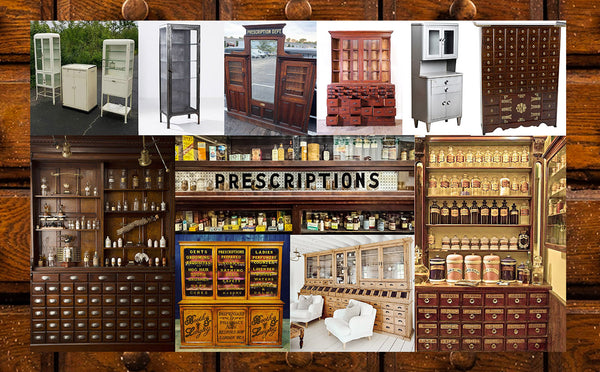
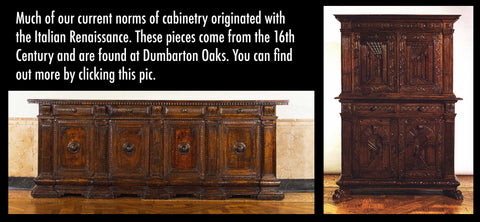
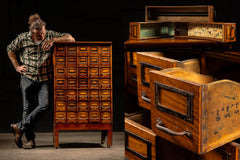
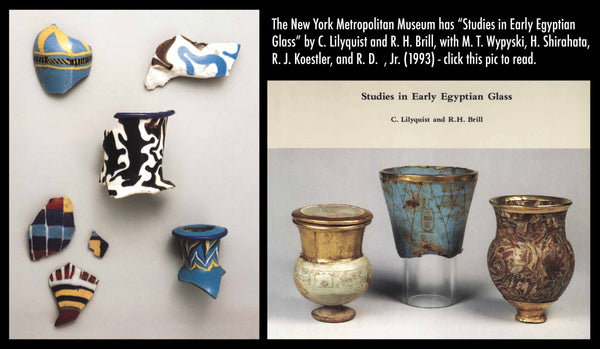
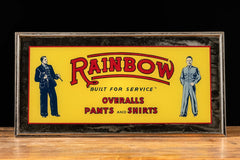
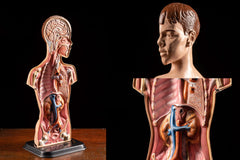




Leave a comment